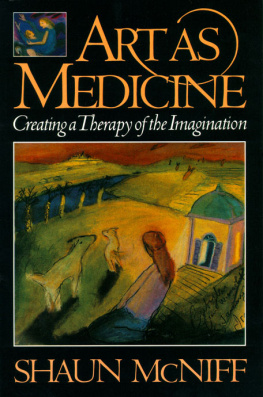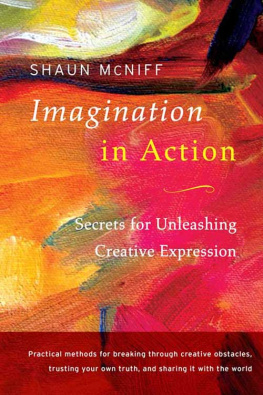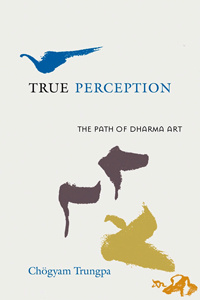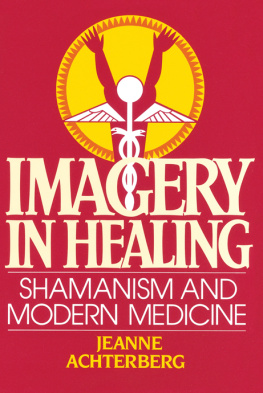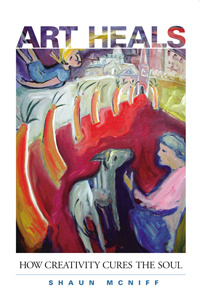This well-written book shows brilliantly the interplay between soul and sacred, art and shamanism, sickness and health. It is a mature product, combining lucid philosophy with hands-on experience, and contains profound insights into the human psyche.
Intuition
The fast-growing field of expressive arts therapy recognizes Shaun McNiff to be its most perceptive pioneer and articulate teacher. Art as Medicine clearly displays his gifts and solidly confirms his reputation.
James Hillman
ABOUT THE BOOK
Whenever illness is associated with loss of soul, writes Shaun McNiff, the arts emerge spontaneously as remedies, soul medicine. The medicine of the artist, like that of the shaman, arises from his or her relationship to familiarsthe themes, methods, and materials that interact with the artist through the creative process. Art as Medicine demonstrates how the imagination heals and renews itself through this natural process. The author describes his pioneering methods of art therapyincluding interpretation through performance and storytelling, creative collaboration, and dialoguing with imagesand the ways in which they can revitalize both psychotherapy and art itself.
SHAUN MCNIFF is internationally recognized as a founder and leading figure in the arts and healing field. University Professor at Lesley University in Cambridge, Massachusetts, he is past president of the American Art Therapy Association and the author of several other books, including Trust the Process and Creating with Others.
Sign up to learn more about our books and receive special offers from Shambhala Publications.

Or visit us online to sign up at shambhala.com/eshambhala.
Shambhala Publications, Inc.
Horticultural Hall
300 Massachusetts Avenue
Boston, Massachusetts 02115
www.shambhala.com
1992 by Shaun McNiff
All rights reserved. No part of this book may be reproduced in any form or by any means, electronic or mechanical, including photocopying, recording, or by any information storage and retrieval system, without permission in writing from the publisher.
Library of Congress Cataloging-in-Publication Data McNiff, Shaun.
Art as medicine: creating a therapy of the imagination / Shaun McNiff.1st ed.
p. cm.
Includes bibliographical references and index.
eISBN 978-0-8348-2728-8
ISBN 978-0-87773-658-5 (alk. paper)
1. Art therapy. 2. Creation (Literary, artistic, etc.)Therapeutic use. 3. Imagery (Psychology)Therapeutic use. 4. Psychotherapy. I. Title.
RC489.A7M356 1992 93-50117
615.85156dc20 CIP
For Jack
In addition to my four children and my wife, Catherine Cobb, who has been a valued listener and critic, other supporters during the hatching of Art as Medicine include Vincent Ferrini in Gloucester; the spirit of Truman Nelson hovering over all of the Essex County coast; my faithful manuscript readers Paolo Knill and Margot Fuchs; Lesley College colleagues and graduate students; Helen Landgarten in Los Angeles and Jacqueline McAbery in San Francisco; Sr. Kathleen Burke and Bruce Moon in Ohio; Jerrilee Cain in Illinois; Lynn Kapitan and Lori Vance in Wisconsin; Bob Blumberg in Iowa; Steve and Ellen Levine in Toronto and Marthas Vineyard; Howard McConeghey in Albuquerque and the Southwestern College community in Sante Fe; Gunda Graenicher in Zurich; Majken Jacoby in Copenhagen; Baruch Zadick and the Arts Institute community in Tel Aviv; and James Hillman and Thomas Moore in the archetypal stream. Sincere thanks to Shambhala Publications and Kendra Crossen for giving me the opportunity to express Art as Medicine in the body of this book, and thanks to Lorraine Kisly for editing the manuscript.
The soul is a very perfect judge of her own motions, if your mind does not dictate to her.... The souls deepest will is to preserve its own integrity, against the mind and the whole mass of disintegrating forces.
Soul sympathizes with soul.
D. H. LAWRENCE (1923)
W HENEVER ILLNESS is associated with loss of soul, the arts emerge spontaneously as remedies, soul medicine. Pairing art and medicine stimulates the creation of a discipline through which imagination treats itself and recycles its vitality back to daily living.
My perspective on medicine is artistic. I will not be making bio-energetic assessments of pulse beats altered by meditations on images. Although the chemistry of the body no doubt changes as a result of artistic expression and reflection, the purpose of this book is to engage them as modes of psychological inquiry. Rather than attempting to explain the artistic emanations of soul, our psychology desires to activate and move soul by striving to speak its own language.
The methods and philosophy in this book are based on principles of dialogue and interplay, Creation is interactive, and all of the players are instrumentalities of souls instinctual process of ministering to itself. Conflict as well as affection propel the process.
Art as medicine does not restrict its interactions to human relationships. Concentration on the other ensouls the world, and paintings are ensouled objects or beings who guide, watch, and accompany their makers and the people who live with them. Their medicine is established by this otherness, which enables them to influence people who open themselves to receiving help from another.
I intend this to be a practical book, based on life experiences, but not limited to descriptions of those experiences. The book is itself a doing, an action in which soul demonstrates how it moves within the individualized yet archetypal context of a persons life. The word soul suggests the essential nature of persons and other phenomena. It is characterized by individuality, the aesthetic quality, or aura, that distinguishes one thing from another. It is also an inner movement or stirring, the force of creative animation and vitality. Soul is closely related to and sometimes synonymous with psyche, daimon, and other words that appear frequently in this text. All of these words emanate from a common mystery. Their purpose is poetic rather than explanatory, and through them the soul experiences itself more deeply. Throughout the book I will use the word image and generally refer to the visual images of dreams and pictures, but movements, sounds, poetry, enactments, and ideas are not excluded from my sense of the word.
As soon as a painting is made, or a dream remembered, the images that constitute their being are experienced as wholly other. This autonomous life of the image is the foundation of a revolutionary and pragmatic treatment of our psychic diseases. We see the dogs, automobiles, houses, and rivers in our paintings and dreams as parts of ourselves, confirming the egocentric madness of our reality. Everything is reduced to the perspective of the experiencing I.
It is through others that we discover who we are. When we learn how to step aside and watch ourselves, the other becomes an agent of transformation. Dialoguing with images is a method for expanding egos singular vision. In opening to others, we do not have to give away our place within the interaction. Others have an experience of us that may be quite different from our experience of ourselves, All of these perspectives are elements in the psychic stew. Reality is an ever-changing interplay and never a single, fixed position.
The dialogue between an artist and a painting is rarely limited to twofold communication, Many figures within the painting and the artist enter these conversations. It becomes increasingly clear that the first-person perspective of the artist, the I who is speaking, is composed of varied voices. On entering the world of the painting, we become aware of the many who speak through us, not just the figures in the pictures, but also the varied aspects of our thought. The articulation of these diverse persons is yet another aspect of image dialogue.
Next page
